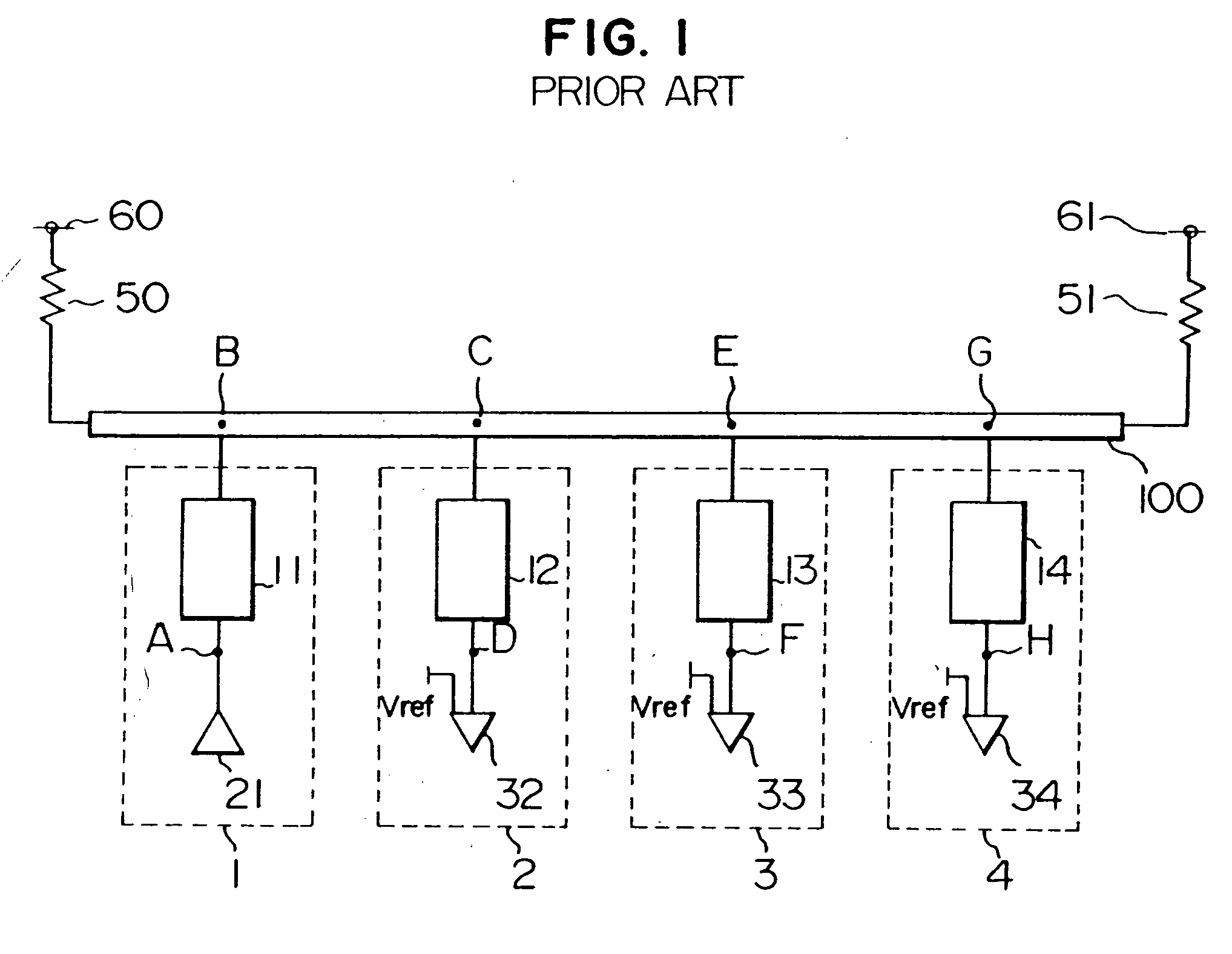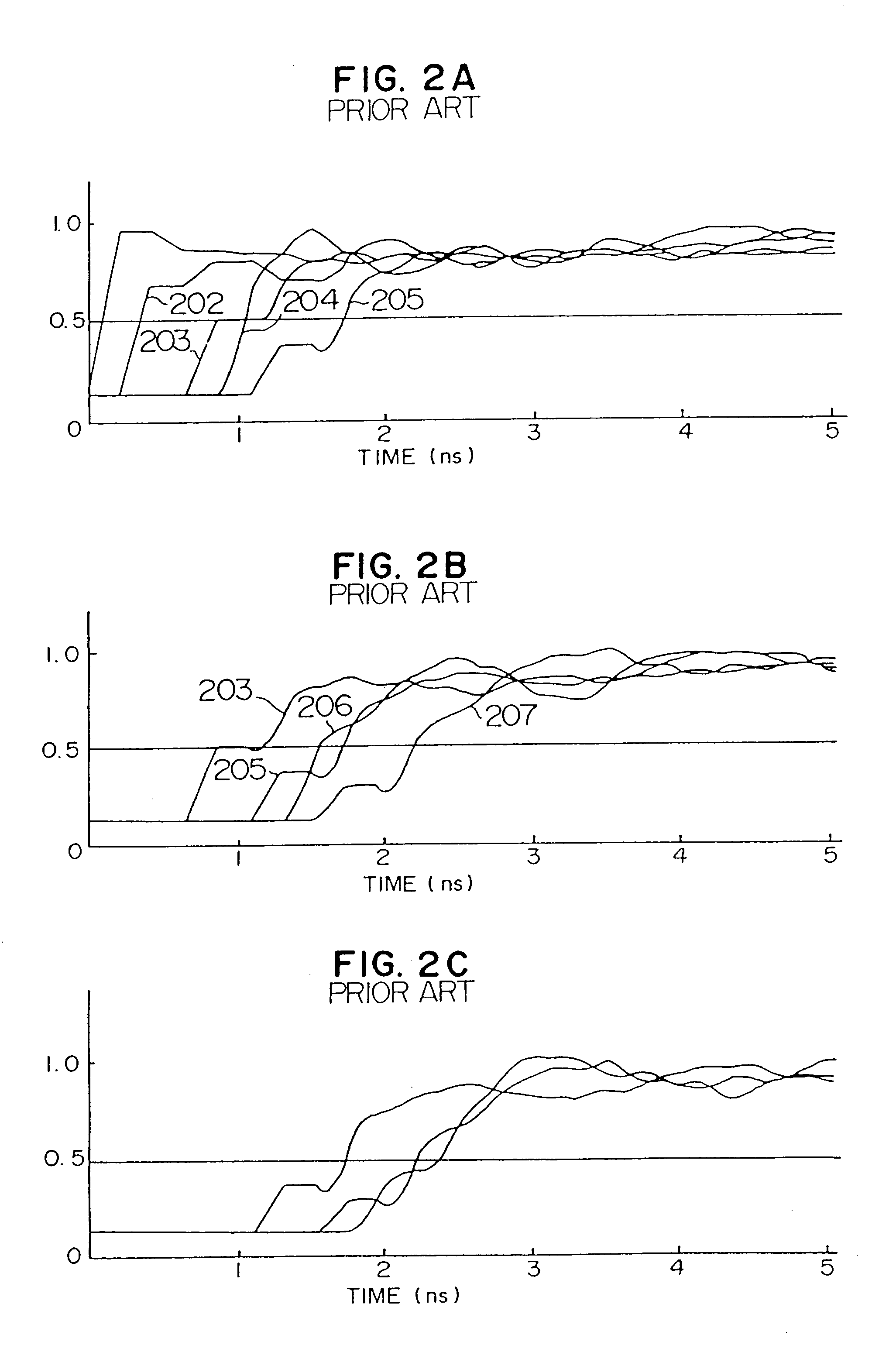Signal transmitting device suited to fast signal transmission
a signal transmission and signal technology, applied in the field of signal transmission devices suited to fast signal transmission, can solve the problems of waveform distortion on the transmission line, receivers not being able to recognize high level, reflection of signal, etc., to reduce line impedance, reduce transmission line amplitude, and quickly transmit signal
- Summary
- Abstract
- Description
- Claims
- Application Information
AI Technical Summary
Benefits of technology
Problems solved by technology
Method used
Image
Examples
embodiment 2
[0100] The following description will be directed to embodiment 2 in which the present invention is applied to a bidirectional transmission line.
[0101]FIG. 11 is a fundamental block diagram showing the second embodiment. The circuit blocks 1 to 4 provide driving circuits 21 to 24, receiving circuits 31 to 34, resistors 80 to 83, and transmission lines 11 to 14, respectively. A transmission line 100 is connected to the circuit blocks 1 to 4 and is terminated by the resistors 50 and 51, each having a resistance equal to a characteristic impedance value of the transmission line 100.
[0102]FIG. 11 shows the transmission line terminated at both ends by the resistors. However, if desired, the transmission bus may be terminated at one end by one resistor. Further, FIG. 11 shows four blocks. In actuality, the present invention may apply to any transmission line if it is connected to two or more blocks.
[0103] The arrangements of the driving circuits 21 to 24 and the receiving circuits 31 t...
embodiment 3
[0113] The following description will be directed to a third embodiment which is particularly effective in the case of providing a large capacitance at the tip of each branched line in a situation where there are many branched lines. FIG. 14 is a fundamental block diagram for explaining a unidirectional transmission bus according to this embodiment. FIG. 15 is a fundamental block diagram for explaining a bidirectional transmission bus according to this embodiment. In FIG. 14, a circuit block 1 includes a driving circuit 21, and circuit blocks 2 to 4 include receiving circuits 32 to 34, respectively. Further, the blocks have resistors 80 to 83 and transmission lines 11 to 14, respectively. In FIG. 15, the circuit blocks 1 to 4 provide sending circuits 21 to 24, receiving circuits 31 to 34, resistors 80 to 83, and transmission lines 11 to 14, respectively. In FIGS. 14 and 15, the transmission line 100 is connected to the circuit blocks 1 to 4, and is terminated by resistors 50 and 51 ...
embodiment 4
[0131]FIG. 27 shows an embodiment in which the driving circuit and the receiving circuit are integrated so that an inter-circuit block transmission line is connected to an intra-circuit block transmission line through an transmission bus like a lead of an integrated circuit.
[0132] In FIG. 27, a numeral 5 denotes an inner circuit block (an inner unit, for example, an integrated circuit) which is mounted on a circuit block 1 (for example, a board having an integrated circuit mounted thereon). Numerals 6 to 8 denote inner circuit blocks having receiving circuits 32 to 34, respectively, which inner circuit blocks are mounted inside of the circuit blocks 2 to 4, respectively. The circuit blocks 1 to 4 have resistors 80 to 83 and transmission lines 11 to 14 and 41 to 44, respectively. The transmission lines 11 to 14 are designed to have the same or almost the same characteristic impedance as that of the transmission lines 41 to 44. Further, the transmission line 100 has the circuit block...
PUM
 Login to View More
Login to View More Abstract
Description
Claims
Application Information
 Login to View More
Login to View More - R&D
- Intellectual Property
- Life Sciences
- Materials
- Tech Scout
- Unparalleled Data Quality
- Higher Quality Content
- 60% Fewer Hallucinations
Browse by: Latest US Patents, China's latest patents, Technical Efficacy Thesaurus, Application Domain, Technology Topic, Popular Technical Reports.
© 2025 PatSnap. All rights reserved.Legal|Privacy policy|Modern Slavery Act Transparency Statement|Sitemap|About US| Contact US: help@patsnap.com



